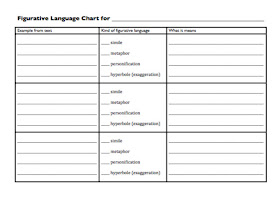One of the key aspects of teaching figurative language is helping students to interpret figurative language. How do we go about doing this? Luckily, the best way to build interpretation skills is by sharing and talking about wonderful poems together.
I shared this stanza from an Emily Dickinson poem with my students:
Frequently the woods are pink,
Frequently are brown;
Frequently the hills undress
Behind my native town.
First we found the personification in the third line. This line makes fourth graders giggle--what is going on? Why is there a poem about undressing?
Once we have identified the personification, we need to think about what the author is trying to reveal. What is the author trying to show us about the trees? What is happening? I taught this with three different groups today, and they all came to their understanding at different points. With one group I had to show the seasonality of the poem (in what season would we find the woods pink? brown?) before they were able to grasp the meaning of the personification. But each group eventually figured out that the slightly shocking "undress"ing that was going on in the poem was really the trees losing their leaves in the fall.
Our next step is to use the Figurative Language chart to identify and interpret figurative language from various poetry books. There are several great things about this chart. On the left hand side, students have to copy the text accurately, building their skills to the "accurate quoting" specified in the Common Core. After choosing the kind of figurative language, students have to interpret it on the right side. I also like to use this chart with short stories and expository pieces that are strong in figurative language, such as "Eleven" by Sandra Cisneros or One Tiny Turtle by Nicola Davies.
Today, I modeled how to use this chart with the book Sierra by Diane Siebert. Teaching children how to just copy a line or two from a poem is important, but it takes time. ("Look at how I am putting the exact same punctuation that the author uses as I write down this line.") The modeling step is also important to show the quality of thinking that you are expecting. Our first example was the simile in the opening lines of the book: "I am the mountain,/Tall and grand,/And like a sentinel I stand." We had to talk about what a sentinel is, how a sentinel is not like a mountain, and how the simile shows us something new about the mountain. One girl expressed it perfectly: "The mountain is like a sentinel because the mountain stands tall and still, just like a sentinel, and it stays there as long as it has a job to do."
Tomorrow, students will work on this with other poems and books from my classroom collection.
I'll be adding the figurative language chart to my figurative language activities in a few weeks. (I have to update the Powerpoint, too, with some new examples and poems!) If you would like it in the meantime, feel free to grab the image or write to me.


No comments:
Post a Comment